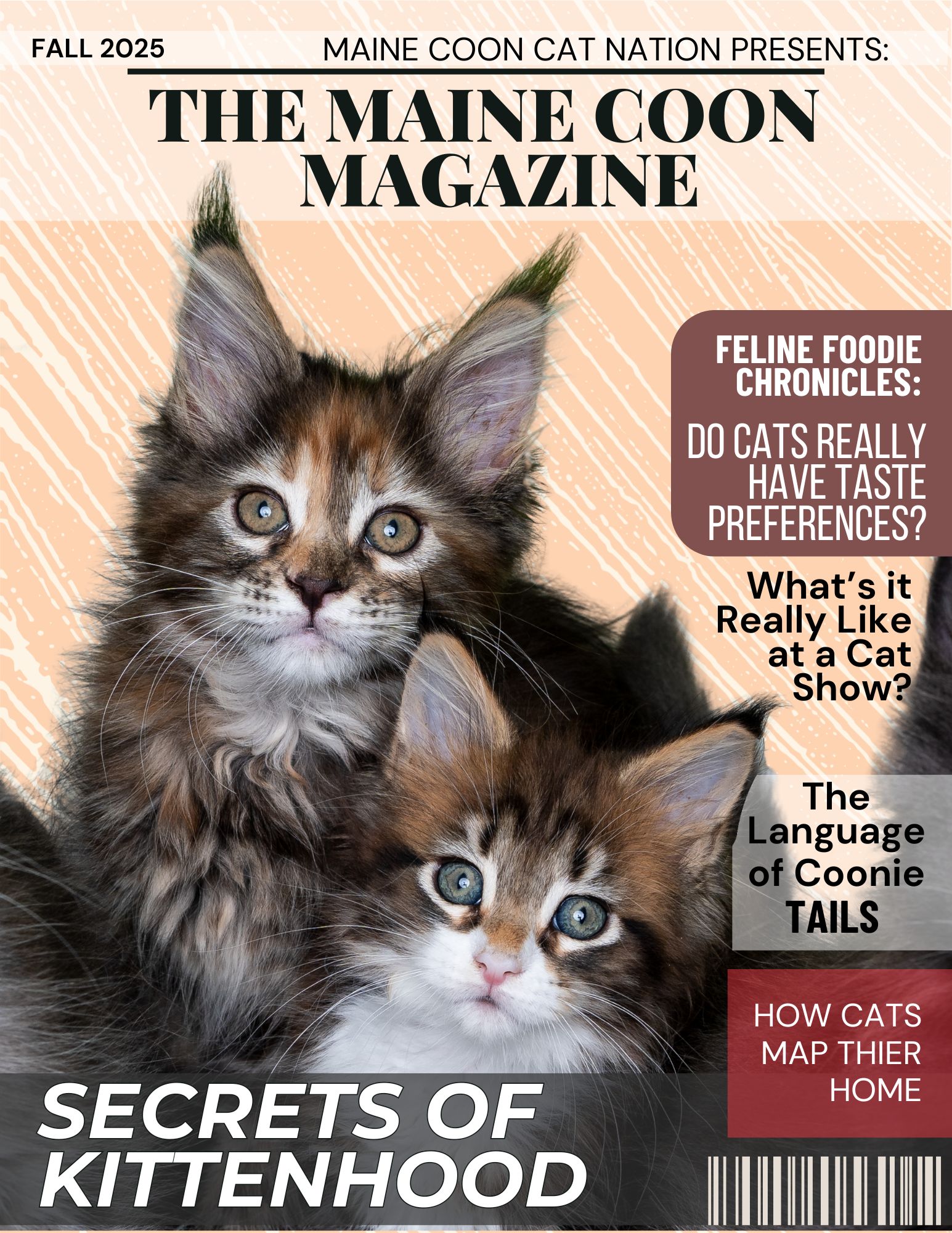- Home
- Maine Coon Grooming
- Give a Cat a Bath
How to Give a Cat a Bath:
Dealing With a Longhaired Coat
Here is the method we use to give a cat a bath, complete with our secret tool! For many of us, bathing is part of Maine Coon cat care.
From time to time, we had to bathe our big Maine Coon cat, Leo and his pretty sister, Alice. We learned a few tricks to keep this task as pain-free for everyone as possible.
Fortunately, the Maine Coon cat breed is very chill and laid back - so that definitely helps. On the other hand, this breed has a thick water-resistant coat which presents challenges of its own!
If you like this, you'll love our fun, free Daily Digest!

If you like this, you'll love our fun, free Daily Digest!

When to Give a Cat a Bath:
You may need to give a cat a bath only rarely, especially if it's an indoor kitty. Bathing an indoor longhaired cat is generally only indicated in specific circumstances, such as:
Accumulation of Dirt or Debris: If your Maine Coon gets into something messy, like paint or grease, a bath may be necessary to remove the substance from their fur.
Skin Conditions: If your kitty has a skin condition that requires medicated shampoos or treatments, bathing may be recommended by your veterinarian as part of their care regimen.
Severe Matting or Tangling: In cases where a feline's fur has become severely matted or tangled and cannot be resolved with brushing alone, a bath may be necessary to loosen the mats before grooming.
Allergies or Irritants: If Fluffy has come into contact with allergens or irritants that are causing discomfort or allergic reactions, bathing may help to remove these substances from their coat.
Foul Odors: If your cat has rolled in something with a strong odor or if they have a strong natural odor due to issues like anal gland problems, bathing can help to eliminate the smell.
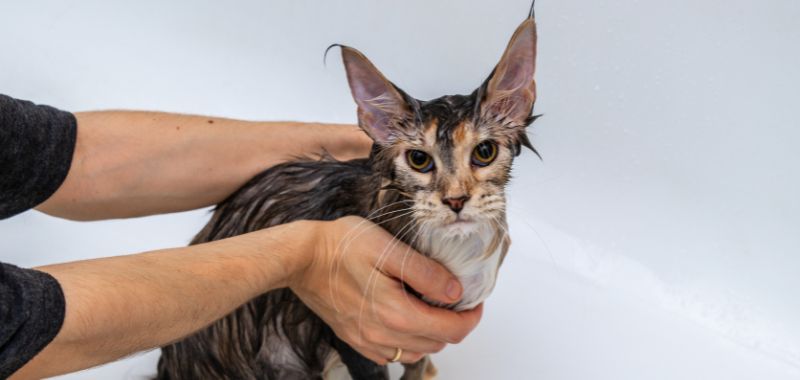
However, it's important to note that most cats are self-grooming and generally do not require regular baths like dogs. Over-bathing can strip their skin and fur of natural oils, leading to dryness and irritation.
Always use a cat-specific shampoo and follow proper bathing techniques to ensure their comfort and well-being.
If you're unsure whether bathing is necessary, consult with your veterinarian for guidance tailored to his or her specific needs.
Longhaired cats generally require more grooming than shorthaired cats due to their thick coats, which can become matted if not properly cared for.
The decision whether to give cat a bath depends on several factors, including their individual grooming habits, lifestyle, and health.
Some longhaired kitties may benefit from occasional baths to keep their fur clean and free of mats, while others may not require baths at all if they groom themselves effectively.
Similarly, shorthaired cats may also need baths occasionally, especially if they get into something dirty or have skin conditions that require special care.
The need to give a cat a bath varies individually, regardless of their hair length.
We started introducing bath-time when our cats were small kittens. We used the bathroom sink when they were tiny, and they got used to it quickly.
In our case, it was necessary because the kittens had diarrhea and it was messy. Then there was the time they each fell in the toilet, but that's another story!
Regardless of need, it's a good idea to acclimate young kittens to being bathed. If they don't 'need' it, it's that much easier to make it a quick affair for the sake of training!
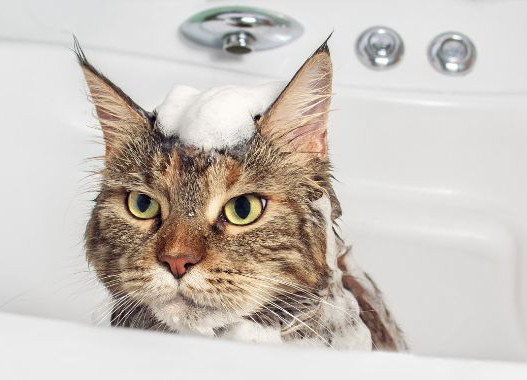
Our Method to Give a Longhaired Cat a Bath:
The first step is preparation. It's key to prepare ahead, and to bring your cat into a calm and quiet bathroom.
The water should be a nice temperature (warm but not hot), tub full to the level you've chosen, and faucet off, before bringing kitty into the bathroom.
Have everything laid out in advance: towels, cup for pouring, and shampoo.
Always use a quality cat shampoo. If you don't have any, and absolutely must bathe the cat now, baby shampoo works. The gentler, the better.
Use a Stool in the Tub to Bathe a Cat!
Here is the secret tool we use to give a cat a bath: A sturdy stool. We would put Leo in the water and get him wet, but you can't shampoo a cat while he's under water! So, we put a stool right in the tub.
He would happily climb up on it after we wet him. This method works great. Then we shampoo him quickly and efficiently. We try to make it as smooth for him as possible.
Maine Coon fur doesn't wet easily. It's designed to keep them warm and dry in the snow and rain, after all.
Maine Coon cats have semi-long fur with a dense, water-resistant undercoat and a longer, water-repellent topcoat.
This unique fur composition helps protect them from moisture and harsh weather conditions, making them well-suited for outdoor environments.
Their fur is designed to shed water and snow, which is an adaptation that likely developed to help them survive in their native environment of cold, damp climates.
It also means that it may take a little more effort to get them wet enough in the bath. With practice, you'll get the hang of it.
Rub some shampoo in, add a little more water until it's all saturated. Then put the cat back in the water, off the stool to rinse.
Rinse well, because he'll be grooming himself for a while. Watch out for the eyes and ears!
If your cat is really desperate to get out, just let him - as long as the shampoo is rinsed out. You want to be able to do it again, so it's best not to traumatize him!
When possible, we would use two people working together. One would hold and reassure the cat while the other would make quick yet gentle work of wetting, shampooing and rinsing.
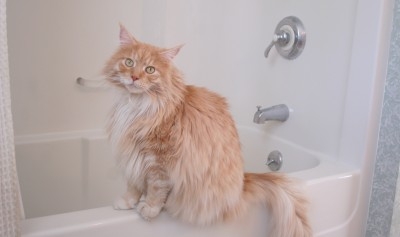
Wrap him right up, dry him a little, and set him on his way. We don't use a hairdryer, it is just too scary.
We would do the bath on a warm day, or when the wood stove was on. Leo liked to hang out there until dry.
Alternatively, you could turn the heat up. Just make sure the cat does get dry pretty soon. This is a good time to do some combing or brushing, too.
Bathing Safety Considerations:
- Use the Right Products: Use a cat-specific shampoo that is gentle and formulated for their skin pH. Avoid using human shampoo or harsh chemicals, as they can irritate the cat's skin.
- Secure Environment: Prepare a warm, quiet, and secure bathing area before bringing your cat in. Make sure all doors and windows are closed to prevent escape.
- Prep Ahead: Have everything you need within arm's reach before starting the bath: shampoo, towels, a non-slip mat for the tub or sink, and a sprayer or cup for rinsing.
- Trim Nails: Consider trimming Kitty's nails beforehand to reduce the risk of scratching.
- Water Temperature: Use lukewarm water—not too hot or too cold. Test the water temperature with your wrist to ensure it's comfortable.
- Gentle Handling: Handle your furry friend gently and speak to them in a soothing voice to help keep them calm. Avoid restraining them too tightly, as this can cause stress.
- Ear Protection: Avoid water getting inside the ears. The safest way to do this is to leave the face and head area alone, unless Kitty has gotten into something the must be washed out.
- Avoid the Face: Be cautious around the face, ears, and eyes. Use a damp washcloth to gently clean these areas instead of pouring water directly on them.
- Quick Process: Keep the bathing process brief to minimize stress. Wet the fur, apply shampoo, lather gently, and rinse thoroughly.
- Dry Thoroughly: Use towels to gently pat the fur dry after the bath. If your cat tolerates it, you can use a blow dryer on a low, cool setting, but be cautious and keep it at a safe distance to prevent burns.
- Monitor Aftercare: Keep an eye on your pet after the bath to ensure they're not showing signs of distress or illness. If they seem unusually agitated or if you notice any skin irritation, contact your veterinarian.
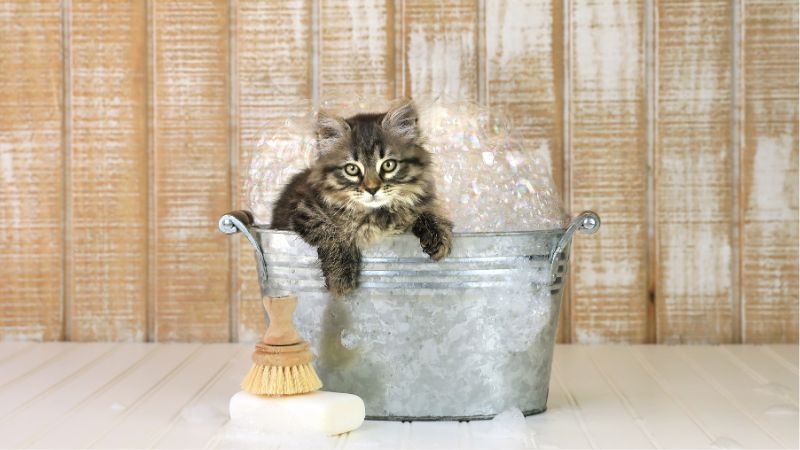
Frequently Asked Questions (FAQ's):
What equipment and supplies are needed to bathe a cat?
What equipment and supplies are needed to bathe a cat?
You'll need cat-specific shampoo, towels, a non-slip mat for the bathing area, a cup for rinsing, and grooming tools like a brush or comb. Optional items include a stool for shampooing time, a blow dryer on a low, cool setting and grooming wipes.
What can I wash my cat with?
What can I wash my cat with?
Using a feline-specific shampoo is important because it is formulated to match the pH level of a cat's skin, preventing irritation.
These shampoos are gentle and designed to effectively cleanse cat fur without stripping away natural oils, keeping the skin healthy and avoiding potential allergic reactions or skin problems.
How often should you give a cat a bath?
How often should you give a cat a bath?
There is no set recommendation regarding bathing schedule. Cats are generally fastidious groomers and rarely need baths, but factors like breed, lifestyle, and health can influence bath frequency.
Most felines only require baths on an as-needed basis, such as if they get into something messy or develop skin conditions.
Longhaired breeds like Maine Coons may need baths more often to prevent matting, while outdoor cats might need more frequent baths to remove dirt and parasites.
Additionally, kitties with certain health conditions may require regular bathing as part of their care routine.
Always consult with a veterinarian for guidance tailored to your cat's specific needs.
How do I get my cat to tolerate baths?
How do I get my cat to tolerate baths?
Managing anxiety and stress during bath time can be crucial for a positive experience.
Consider using pheromone sprays or diffusers, which emit calming scents to help relax your kitty. Playing soft music or using white noise machines can also create a soothing environment.
Additionally, gradually desensitizing your cat to water and the bathing process through positive reinforcement training can help reduce anxiety over time.
When should a cat go to the groomer for a bath?
When should a cat go to the groomer for a bath?
Professional grooming services can be beneficial for cats with specialized needs or grooming challenges.
Kitties who resist grooming, have severe matting, or require specific treatments like medicated baths may benefit from the expertise of a professional groomer.
Additionally, cats with mobility issues or medical conditions that make grooming difficult may require professional assistance to ensure their grooming needs are met safely and effectively.
Start young, and do this regularly for a clean, beautiful cat! Finding the best method to give a cat a bath can be a chore, but it's worth it.
« Back to Maine Coon Grooming
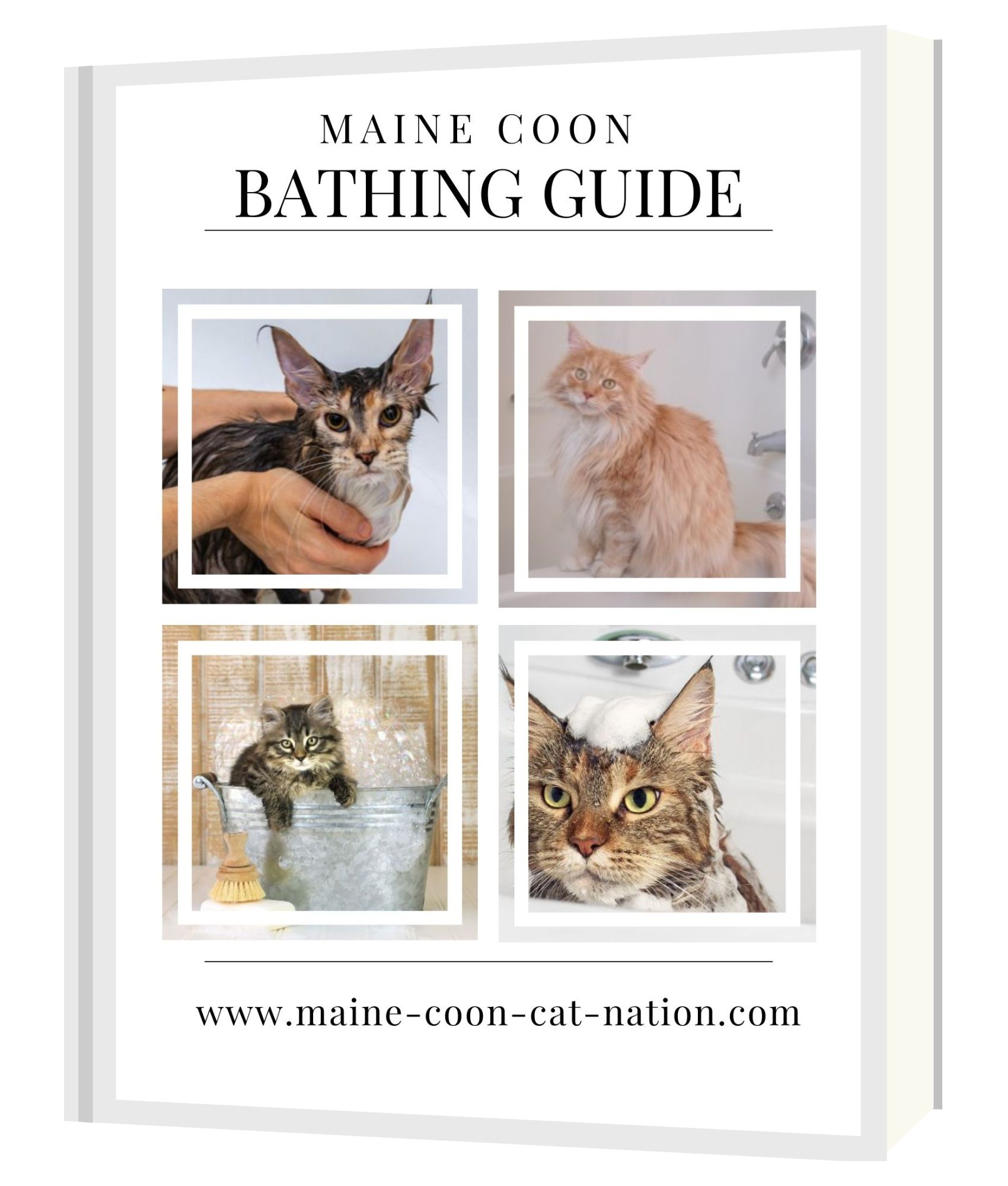
MCCN Members: This Bathing Guide is available in your membership for download, ad-free and formatted for easy reading on any device. You can see it here.
If you're not a member and want to learn more about this, click on the Learning Center below!
